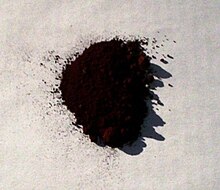Our website is made possible by displaying online advertisements to our visitors.
Please consider supporting us by disabling your ad blocker.
Lead dioxide
 | |
 | |
| Names | |
|---|---|
| IUPAC name
Lead(IV) oxide
| |
| Other names
Plumbic oxide
Plattnerite | |
| Identifiers | |
| ChemSpider | |
| ECHA InfoCard | 100.013.795 |
| EC Number |
|
PubChem CID
|
|
| RTECS number |
|
| UNII | |
| UN number | 1872 |
CompTox Dashboard (EPA)
|
|
| Properties | |
| PbO2 | |
| Molar mass | 239.1988 g/mol |
| Appearance | dark-brown, black powder |
| Density | 9.38 g/cm3 |
| Melting point | 290 °C (554 °F; 563 K) decomposes |
| insoluble | |
| Solubility | soluble in acetic acid insoluble in alcohol |
Refractive index (nD)
|
2.3 |
| Structure | |
| hexagonal | |
| Hazards | |
| GHS labelling: | |
   
| |
| Danger | |
| H272, H302, H332, H360, H372, H373, H410 | |
| P201, P202, P210, P220, P221, P260, P261, P264, P270, P271, P273, P280, P281, P301+P312, P304+P312, P304+P340, P308+P313, P312, P314, P330, P370+P378, P391, P405, P501 | |
| NFPA 704 (fire diamond) | |
| Flash point | Non-flammable |
| Safety data sheet (SDS) | External MSDS |
| Related compounds | |
Other cations
|
Carbon dioxide Silicon dioxide Germanium dioxide Tin dioxide |
| Lead(II) oxide Lead(II,IV) oxide | |
Related compounds
|
Thallium(III) oxide Bismuth(III) oxide |
Except where otherwise noted, data are given for materials in their standard state (at 25 °C [77 °F], 100 kPa).
| |
Lead(IV) oxide, commonly known as lead dioxide, is an inorganic compound with the chemical formula PbO2. It is an oxide where lead is in an oxidation state of +4.[1] It is a dark-brown solid which is insoluble in water.[2] It exists in two crystalline forms. It has several important applications in electrochemistry, in particular as the positive plate of lead acid batteries.
- ^ Meek, Terry L.; Garner, Leah D. (2005-02-01). "Electronegativity and the Bond Triangle". Journal of Chemical Education. 82 (2): 325. Bibcode:2005JChEd..82..325M. doi:10.1021/ed082p325. ISSN 0021-9584.
- ^ Eagleson, Mary (1994). Concise Encyclopedia of Chemistry. Walter de Gruyter. p. 590. ISBN 978-3-11-011451-5.
Previous Page Next Page



